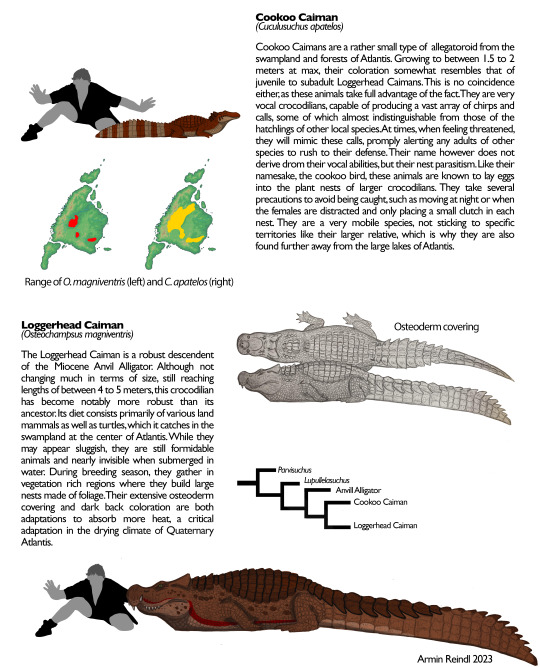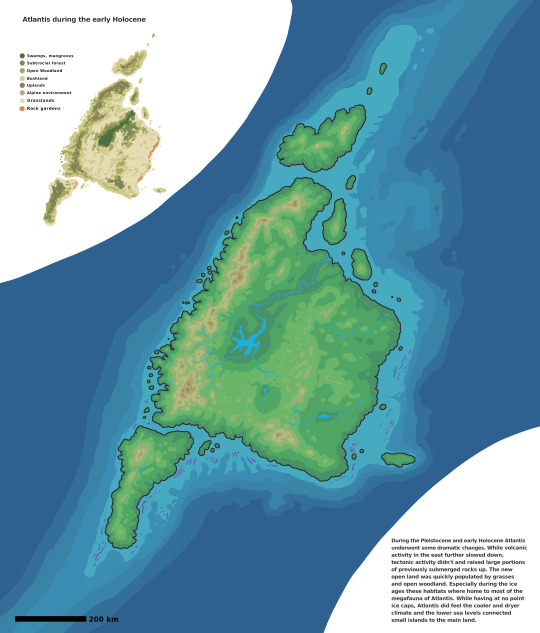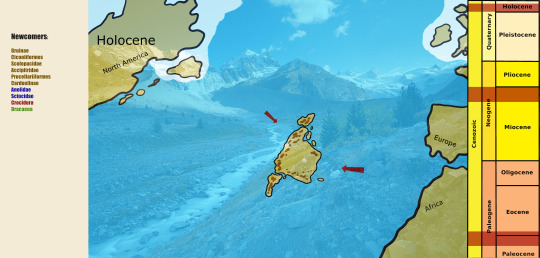#atlantisbestiary3
Text

Atlantis Phase III is here. Over the next few weekends we will put together the ecosystems of this island during the late Pleistocene, based on community submissions.
The open woodlands have some charismatic megafauna to offer, from truncotheres with bad haircuts over antler wearing birds to large mustelids and turtles.

This image also demonstrates very well the beauty of Atlantis in this form: perfectly balanced between majesty and silliness ;)
#paleoart#atlantisbestiary3#atlantis#specevo#speculative evolution#sciart#paleostream#forest#microfauna#insects#turtle#truncothere
213 notes
·
View notes
Text



About a week into the ongoing Atlantis Challenge by @knuppitalism-with-ue and these are my current entries. I want to challenge myself this time by going with different mediums of art for the individual entries as well.
Unsurprisingly, my favourite entry concerns the two species of crocodilians I submitted, both with their own inspiration. Obviously the cookoo caiman is inspired by cookoo birds, but theres also elements of chinese alligators (for being "chatty") and dwarf caimans (for wandering around). The whole "chirping to get the attention of larger species" is partially inspired by an annectode of researchers handling the juvenile of a smaller species (iirc a New Guinea, tho I might be wrong) only to be charged by a large adult saltie. The Loggerhead takes its design from extinct species like Kinyang and Baru, making my gator from phase 2 more robust. The flaring tail osteoderms are an exaggerated version of something I've seen in a particular Orinoco croc. Both were drawn traditionally with pencil and colored digitally.
The Zeus quail is mostly for fun. Again based on an entry from last phase (the Olympian quail) I went all out with the Zeus comparisson because idk, felt like it would be interesting. The anatomy is based on large, robust birds like grouse. Obviously I used watercolors in the execution.
And then there's the Garden Howler, an ape like plesiadapiform with a face only a mother could love. Hell even as the creator I think they are ugly as sin, but thats the point. Fully digital is not something I do a lot, but again, experimenting. Inspiration comes from both the Greek Sirens (the bird like ones) sitting in rocky areas and singing (like howlers monkeys or gibbons in this case). There's obviously elements of proboscis monkeys and a touch of mermaid hints with their habit of diving into water if available.
163 notes
·
View notes
Text

Atlantis Phase III is here. Over the next few weekends we will put together the ecosystems of this island during the late Pleistocene, based on community submissions.
Oh look, it's the swampy bois and their murky home.
#paleoart#atlantisbestiary3#atlantis#specevo#speculative evolution#sciart#swamps#crocodile#pantodont
200 notes
·
View notes
Text

Atlantis Phase III is here. Over the next few weekends we will put together the ecosystems of this island during the late Pleistocene, based on community submissions.
On Atlantis limestone caves and lave tubes are equally inhabited by a wide variety of creatures. Some of them permanently inhabiting the dark.
#paleostream#palaeoblr#specevo#speculative evolution#atlantis#atlantisbestiary3#truncothere#pantodont#paleoart#sciart#pleistocene
187 notes
·
View notes
Text

Atlantis Phase III is here. Over the next few weekends we will put together the ecosystems of this island during the late Pleistocene, based on community submissions.
The truncothere steppe includes the most megafauna of Atlantis. Large herds of coronolambdids (cimolestids), hippolambdines (pantodonts) and of course truncotheres (pantodonts) roam the plains.
#paleostream#palaeoblr#specevo#speculative evolution#atlantis#atlantisbestiary3#truncothere#pantodont
159 notes
·
View notes
Text

Truncotheres are a clade of animals endemic to Atlantis, they lead to Plato writing about the presence of elephants on the island. In reality these are pantodonts, a clade of animals that went extinct elsewhere at the end of the Eocene.
#paleoart#atlantisbestiary3#sciart#atlantis#truncotheres#pantodont#mammal#speculative evolution#specevo
151 notes
·
View notes
Text

Atlantis Phase III is here. Over the next few weekends we will put together the ecosystems of this island during the late Pleistocene, based on community submissions.
The forests of Atlantis harbor some fantastic fauna and a lot of yet to be studied flora. In the open plains large mustelids are the apex predators, here this role is filled by terrestrial crocodilians.
#paleoart#atlantisbestiary3#atlantis#specevo#speculative evolution#sciart#swamps#crocodile#pantodont#paleostream#forest
149 notes
·
View notes
Text

Atlantis Phase III is here. Over the next few weekends we will put together the ecosystems of this island during the late Pleistocene, based on community submissions.
The Rock Gardens are a new habitat on Atlantis. They formed when the sea level fell and tectonics rose the East of the island. The thick, exposed reef packages quickly eroded into fantastic shapes and rocky labyrinths.
These landscapes are home to one of Atlantis' most iconic creatures, the garden howler.
141 notes
·
View notes
Text

Atlantis Phase III is here. Over the next few weekends we will put together the ecosystems of this island during the late Pleistocene, based on community submissions.
The leaf litter is worthy of its own image. Small critters are a rare thing in spec evo. Here our participants go down to minuscule creatures like nematodes. Beatles, ants, katydids, snails, crustaceans etc.
Some groups here are rather unique, like the eusocial crickets.
#paleoart#atlantisbestiary3#atlantis#specevo#speculative evolution#sciart#paleostream#forest#microfauna#ants#insects#turtle
147 notes
·
View notes
Text

Atlantis Phase III is here. Over the next few weekends we will put together the ecosystems of this island during the late Pleistocene, based on community submissions.
The beaches of Atlantis are the topic of this piece. Small and large pinnipedes can be found here, as well as many birds and small reptiles. Also note the Rosy Pines in the back.
110 notes
·
View notes
Note
sorry which are the nematodes in that leaflitter image, I can see an earthworm (Annalida), what looks like a hammerhead worm (Platihelminthese), and possibly some other flatworms?

Look closely

closer!

nearly there!

There you go, thank you Gasterophis!
97 notes
·
View notes
Text

I forgot to post here on April the first!
Little introduction maybe: In this project we explore the flora and fauna of Atlantis through time, in three phases. Paleocene and Miocene are already done. People can send in submissions based on the parameters I established
For information on phase II check out our google folder https://drive.google.com/drive/folders/1oRJKZr0yDHwnzQQRcHj30r-8JTr4de5U?usp=sharing
This month we start into Atlantis phase 3 in which we will explore the organisms on this island during the Younger Dryas, the transition from the Pleistocene to the Holocene at the end of the last Ice Age
To bring you up to speed what happened since we saw Atlantis the last time:
-The Atlantic has spread further but not much, volcanism in the east slowed further but the whole landmass was lifted up and the sea level is lower increasing the landmass with wide open steppes towards the east.
-The cooler and drier climate lead to the extinction of quite a few animals but the ecosystem is established enough that it's not as impactful. Subsequently few newcomers establish themselves on the island.
-We have snow on the peaks of some mountains and volcanoes but no real ice caps.
-The forests have shrunk further and are now especially concentrated around the central large wetland and on the west flanks of the western ridge, where fog-forest like conditions can occur.
-the lifted up carbonate platform in the east eroded in some areas in a way that the coastal rock gardens have appeared as a new habitat.
-Up in the mountains the slopes are often covered in forests of Megacannabis, not too different from bamboo forests in Asia.
-Underwater we say goodbye to the rudists, corals and sponges are the main reef builders but they are pushed further to the south, occurring now mainly around the southern
In this new scenario you will need to work with what is left.
Evolve the remaining taxa into new forms to fill the new and changed environments OR
choose one of the new arriving clades that came here thanks to rafting events.
The Newcomers:
Gruinae
Ciconiiformes
Scolopacidae
Accipitridae
Procellariiformes
Carduelinae
Anolidae
Scincidae
Crocidura
Dracaena

Posting Guide
Please use only clades from the newcomer list or survivors of the mass extinction as a base for the new biota. Check our Atlantis Phase 2 document for what you can work with!
Entries should be submitted here on Discord or under the hashtag #AtlantisBestiary3
Other than Discord you can submit on: DeviantArt, Twitter and Facebook and Instagram.
Entries have to include an image of the species you want to submit, purely written
entries are not possible!
Besides the image it is best to include a description of the species you show. It’s best
to keep it short and to have it on the image or as a separate image as well as in your post. That way we can easily find your work while going through the entries in our folder or the channel.
Descriptions best should look like this
-Species name
-Creator
-Clade
-Habitat
-Size (please use the metric system like civilized people)
-Ecology
-Additional information if needed/wanted
Basically any visual medium is possible, drawing, painting, digital, clay, animation etc. whatever you feel comfortable with!
When working with traditional media make sure you get a scan or a good photo of the piece if possible, I want to be able to see what you worked on!
Up to 60 entries are possible, multiple species per entry are allowed but don’t overdo it!
DEADLINE IS 30. of APRIL!
#paleoart#sciart#atlantis#atlantisbestiary3#specevo#animals#truncothere#palaeoblr#speculative evolution
82 notes
·
View notes